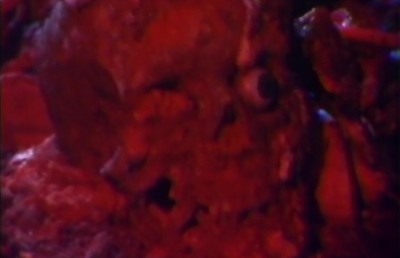Starship Troopers (Paul Verhoeven, 1997): A Different Kind of Bug Movie
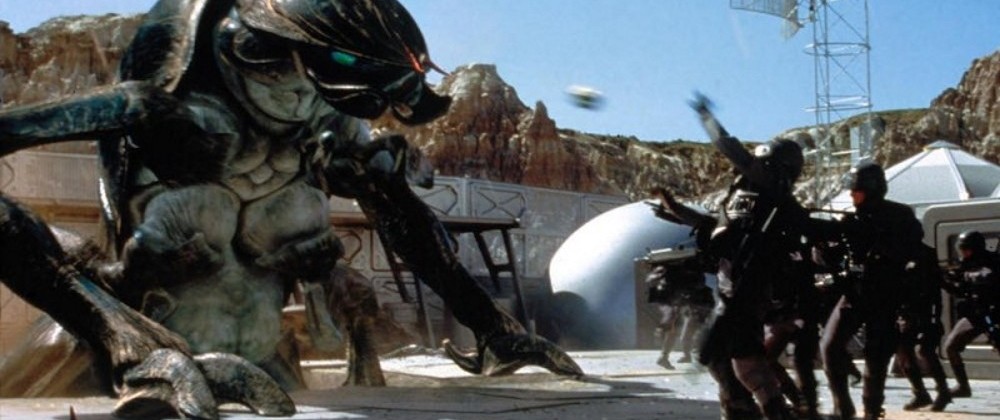
Paul Verhoeven’s Starship Troopers (1997) is curiously foreboding in view of the 2003 US-Iraqi War, but it is also extremely fascinating because it opposes an anti-conformist vision of the sci-fi genre as it radically parodies the ideological military conservatism and pan-Americanism of Independence Day (Roland Emmerich, 1996); and yet, both films have the commonality of the new computer software, replacing ‘star power’ with massive special effects {such as the infamous ‘morphing’ techniques used in Terminator 2 (1991)} which simulate the hyperbolic obscenity of extreme violence in hyper-real warfare rather than advancing the plot of a compelling story. The film’s apparent ideological totalitarianism is a byword for the future is now, one that ironically reflects the unilateral morality of an American monopolistic world order, as it counters the hegemonic belief in an educational dogma based on the untouchable linearity of history. Starship Troopers creates a problematic of history and reality within a modern industrially driven high tech war machine, as explained by J. P. Telotte’s article, entitled “Heinlein, Verhoeven, and the Problem of the Real: Starship Troopers” (Telotte 196).

Verhoeven’s film feeds on the controversy generated by one of the most unpleasant books in the history of popular fiction, Robert Heinlein’s 1959 novella titled Starship Troopers. It is the curiously pragmatic and controversial subtexts of American democratic supremacism and supranational militarism that Verhoeven uses in his film which makes it richly deserving of critical analysis. Unlike some of his contemporaries who build their films on subtle memories from the past (e.g. Francis F. Coppola’s The Rainmaker (1997), a David and Goliath type film, scented with the early social tumults of the 1950s but vitalized with the resilient tenacity of the 1930s, which depicts a young southern lawyer battling an evil insurance giant), Verhoeven constructs his film on the inscribed memories of propaganda films, mirroring the kind of war movies made during WWII, especially of ‘Nazi’ imagery. In fact, Starship Troopers is driven by an ultra high tech communication grid, one which opens the film with a propaganda barrage from the Federal Network, an establishing sequence which sets the narrative within a ‘media’ context without which, there would be an absence of narrative context. Moreover, the film’s emphasis on a ‘media’ presentation places the viewers within the disorientating environment of a postmodern audiovisual culture, just as in the disorientation effects of the information overload of the US-Iraqi War coverage.
Verhoeven’s Starship Troopers extends itself well beyond the cinema of science fiction. It is concerned with exploring the human condition at the turn of the second millennium, by examining the reality of the world situation as a kind of border game which he represents in his film as a perpetually mediated experience. Thus, Starship Troopers is an audiovisual paradigm for Jean Baudrillard’s “The Ecstasy of Communication” (Baudrillard 126). Narrative resolution in this film, if any, is problematic due to the pervasively de-realizing presence of opto-electronic connections. Moreover, this borderline interplay is reflected in the film’s characterization which creates ‘detached’ figures who are dropped onto a faraway desert planet, Klendathu (ref. Iraqi desert), an alien world infested with presumably intelligent giant bugs which are more like single-minded killing machines (ref. Al-Qaeda terrorists) than ‘run-and-scatter’ quasi-organized insects (ref. Hamas suicide bombers). This observation is somewhat related to Baudrillard’s concept of astronautic identity which represents the perplexingly inevitable situation of postmodern humanity, of the individual continually spiraling about himself in search of his identity, as Baudrillard explains: “[the ‘self’] isolated in a position of perfect sovereignty, at an infinite distance from his original universe; that is to say, in the same position as the astronaut in his bubble, existing in a state of weightlessness … in perpetual orbital flight … [around] his planet of origin” (Baudrillard 17). However, Starship Troopers does not quite attain the level of astronautic identity; instead, this film represents the liminal juncture where the individual locates himself within such a de-realized world. The film depicts a hyperreality where the absolute reliance on electronic mediation becomes problematic because recurrent equipment failures lead the troopers to suffer massive casualties and devastating defeats. Starship Troopers effectively dramatizes the continual state of perplexity which exists in cogitating about, living in, and fighting within a de-realized environment.
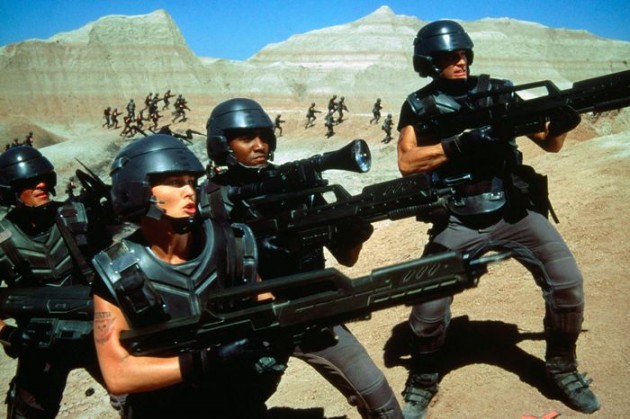
Interestingly, Baudrillard’s “Ecstasy of Communication” does not extol a condition of alienation because it functions bilaterally with regards to the incessant mediated experience. As mentioned above, the propaganda bombardment resulting from the US-Iraqi War is quite disorientating; conversely, the ‘new’ imaging technologies have played a crucial role in alleviating much of this disorientation since they allow us to participate in a fascinating ‘drama-at-a-distance’ against the perceived alien threat (ref. Iraqi weapons of mass destruction). As Telotte explains: “… the science fiction genre has always made great capital from visualizing alien, futuristic, and apocalyptic environments, from catering to our wonder at what strange realities could be … Starship Troopers doesn’t interrogate its reality in quite this problematic way {ref. Verhoeven’s strained and artificial environments of Earth in Robocop (1987); his uncertain dreamscape and its hostile environments of Mars in Total Recall (1990)}, it places its key figures constantly on alien worlds, in damaged spaceships, in nightmarish, seemingly hopeless situations, far removed from their home planet and out of contact with their fellow human beings … we might say that alienization is the order of the day here” (Telotte 197). Strangely, Verhoeven has fashioned a very unreal world from the work of an author who has been extolled for a fastidious grounding of his narratives in a form of sci-fi realism, one in which they were socially contextualized. Yet, Heinlein’s work after WWII is a form of sci-fi literature directed at the juvenile market, combining his own purposeful propaganda with the romantic. Such ‘juvenile’ sci-fi novels are marked with exaggeration and the hard details of science, as compared with the wholesomeness of his ‘adult’ novels. It is Heinlein’s dual pull, resulting from a fascination with detail {e.g. Irving Pichel’s Destination Moon (1950), co-scripted by Heinlein, details the psychological life of the astronauts} and a juvenile form of imaginative exaggeration, which partially creates the undercurrent for a problematic sense of reality in Starship Troopers; and even though they polemically investigate the thematic instability of the sense of ‘moral certainty’ within their narratives, their similarity quickly vanishes as the written word makes way for film. Polemically, Starship Troopers is less an argument against modern ideologies than one that generates ‘new’ ideas and an ‘alternative’ way of seeing the modern dilemma.
Starship Troopers is scripted by Ed Neumeier who totally rewrites the plot, changing the characterization of pivotal figures and leaving out the technology of powered armor, turning the ‘mobile infantry’ into a conventional force. While Heinlein specifically states that the ‘Terrene Federation’ is a representative democracy, Neumeier makes the government a fascist state, imbuing the narrative with such bywords as: “It’s never a soldier’s business to decide why he fights” {ref. Frank Capra’s documentary series Why We Fight (US: 1942-44)} and “A human being has no natural rights of any nature.” Moreover, the book is multiracial while the film is not. The young troopers are figured with Nazi-style imagery which invites the audience to compare the controlled mediated experience to 1940s German propaganda films and radio broadcasts; and as the film intercuts bloody battle scenes with mediated infomercials, the spectator begins to notice an American civil defense ‘bunker mentality’ reminiscent of the 1950s. Neumeier’s script describes vast legions of relentless, malevolent giant insects which represent a ‘new’ kind of enemy, a cultural other to be feared; thus, the film expounds the theme of xenophobia. In a Los Angeles Times article, Neumeier recalls a junior high school science teacher’s words, as he speaks to a reporter about Starship Troopers: “ ‘The Chinese, they’ll march at you like zombies with wooden sticks in their hands, and even if you had a machine gun in your hand, they’d overwhelm you.’ That’s what I think about the bugs” (Kronke 1). Neumeier reintroduces the paranoia of Orientalism into his screenplay, paralleling Heinlein’s novelistic depiction of the 1950s paranoia emanating from the Red Chinese scare; indeed, he links this ‘free-world’ neurosis within the social contexts of the stalemated events and subsequent unease and weak détente between the East (ref. inhuman socialist insects) and the West (ref. human freedom fighters) in the aftermath of the Korean War, and of the ‘Sputnik anxiety’ reifying Bertrand Russell’s concept of Mutually Assured Atomic Destruction (MAAD). In fact, the figurative Asian ‘body-and-face’ which represents cultural ‘otherness’ is presented in the inhuman forms of the insect bodies; moreover, their human absence reinforces the bug’s inhuman presence, compounding the fear of the cultural other. The above argument evidences Neumeier’s conception of the United Citizen Federation (UCF) as a fascist government since the lack of Asians undermines any possibility of a democratic globalism, as well as pointing to the perceived political danger of a growing Asian population which the film materializes as a cunningly intelligent non-human mind and imperviously invulnerable insect body. Hence, Starship Troopers transfers the fear of cultural otherness onto the enemy arachnids, as it transmutes onto the screen a pertinent perception within an overall socio-political context of the 1990s global affairs, where the rapid escalation of military fascism has expressed itself from Iraq to North Korea; and most of all, where the enormous growth of the Chinese economy has strongly affected the world market place.
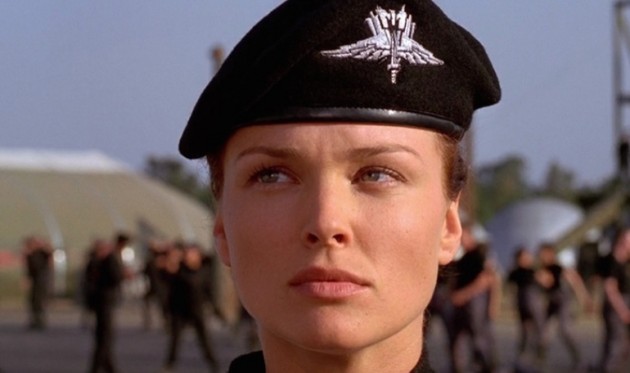
In Starship Troopers, the process of natural selection is shifted into a form of Neo-Darwinism in which cybernetic selection rules over the natural and artificial spaces. Frank H. Tucker explains that: “ … reference to Darwinism occurs in Starship Troopers (Heinlein’s novel) with some worried musing that because a certain planet (Earth) lacks radiation in its atmosphere there will be no mutation, thence no zoologic competition and no progress in life forms … application of Darwinian thought to the new situations created by the discovery and development of new frontier lands was made by Charles Darwin himself, in The Descent of Man, where he pointed out that a kind of selection process operated when people made the choice to go out to the ‘New World’ of the Western Hemisphere during the era of settlement” (Olander 174). While Heinlein views space exploration as another form of colonization with the potential of draining Earth of its best minds, Neumeier imagines it as assimilated species techno-integration dominated by ethnocentric humans. Interestingly, while the UCF’s main mass-mediated war motto is “the only good bug is a dead bug,” there is also “know your foe” which implies the gathering of information. This is depicted in the film by a monstrous parody of the fascist portrayal of Colonel Carl Jenkins (played by Neil Patrick Harris of Doogie Houser, M.D.) who is a psychic prodigy working for the State ministry of Games and Theory. His duties are to gather intelligence at any cost and by any means, and to uncover the secrets of the brain bug’s genetic codes which can lead to a thorough understanding of both their organically pervasive communication network and their reproductive evolutionary adaptations. Indeed, Colonel Jenkins’ character closely resembles Dr. Mengele, the Nazi doctor who conducted sadistically monstrous genetic experiments on the captives of the German concentration camps. At a more public level, there is the promulgation of entomological genocide where the bugs have been systematically exoticized to the point of xenophobic demonomy; thus, the imperious eradication of the insectile dominion must also be commensurate with the catharsis of all forms of entomophobia, especially arachnophobia, through a process of arresting the pursuit of any truth about the unknown and unknowable cultural other. Fascinatingly at a more secretly private level, a much more revealing process is taking place since Jenkins knows intuitively that the bugs’ weapons are their nearly impervious bodies and their colonizing efforts of other planets are based on natural reproduction; thus, the Insecta of Klendathu are an ‘anti-technological’ species (similar to human races) that empower themselves with an organic war machine which depends on biological manipulations and socially stratified operations, ranging from infantry warrior bugs to a single giant queen-like brain bug; yet one which sadistically needs, in the most obscene manner, to suck out the cerebral contents from the crania of its human captives in order to gather its own intelligence. Unlike the mass propaganda which it feeds to its population, the UCF’s interstellar ‘foreign’ policy is not to completely wipe out the inhabitants of Klendathu; but more precisely, it is to totally dominate all spaces that connect them by a combined process of merging of spaces and bodies. There is no question that the humans are envious of the bugs’ great powers, such as those of the plasma bugs who are equipped with internal organs that act like Howitzer ‘super gun’ artillery; indeed, something that the humans do not have but badly need, as evidenced by their total lack of powered armor. Amazingly, the plasma bugs can shoot ionizing plasma bursts, out of their abdominal recta, which can reach into outer space and destroy the Federation’s incoming battle cruisers; moreover, the bug’s chemical biologics (ref. Saddam Hussein’s biochemical weapons) are so advanced that they can even reach Earth (ref. Israel), light years away, effectively becoming interstellar ballistic missiles which eventually destroy Buenos Aries, Argentina (ref. Tel Aviv). On a semi-covert level, the Federation’s Games and Theory laboratories (ref. a CIA working for the Corporate Industrial Conglomerates) are using all forms of perversion in their intelligence work.
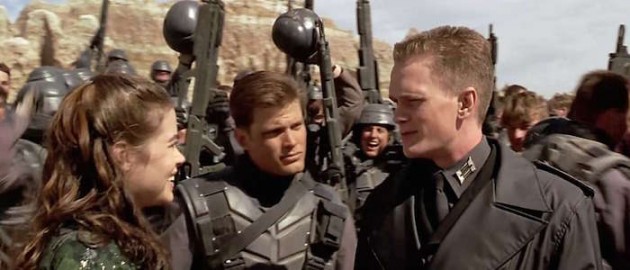
In concluding this essay, several interesting ideas will be injected in its summary. First, it should be pointed out that there is one area where Verhoeven’s film is strictly faithful to Heinlein’s novel, it is in its treatment of women. In Starship Troopers, women and men appear to participate in all forms of human activity. Secondly, there is an explicit depiction of the act of euthanasia, an authorial commentary about issues of life and death, since normally Marines (represented by the ‘Mobile Infantry’) take care of their wounded comrade on the battle field; but when the platoon sergeant is gabbled and carried off to a ledge by a flying hopper bug, the lieutenant uses a sniper rifle to shoot the critically wounded sergeant rather than zeroing out the bug. This is a significant scene because it implies a drastic change in attitude in the overall political matrix of human society, one that does not differentiate between the slaughter of men or women. The world of Starship Troopers defines a ‘new’ kind of existence with ‘new’ ways of seeing, distant and detached ways, which promote the cybernetic technologies that reproduce for us the accidents of reality itself, and it does so in the form of Baudrillard’s Simulacra. Paul Verhoeven’s film attempts to redirect our attention from the obviously direct presentations of extreme violence to a focus on recuperation of our sense of reality, as a way of seeing outside the modern high tech machine.
BIBLIOGRAPHYBaudrillard, Jean. “The Ecstasy of Communication.” In The Anti-Aesthetic – Essays on Postmodern Culture. Seattle, Washington: Bay Press, 1983, pp. 126 – 134.
Baudrillard, Jean. The Ecstasy of Communication. Trans. Bernard and Caroline Schutze. New York: Semiotext[e], 1988.
Burdeau, Emmanuel. “A good bug is a dead bug.” Cahiers du Cinema. January 1998. No. 520, 62 – 63.
Heinlein, Robert A. Starship Troopers. New York: G. P. Putnam & Sons, hard cover edition published 1959 [New York: Ace Books, soft cover Ace edition published May 1967].
Honore, Christophe. “Peep-show troopers.” Cahiers du Cinema.” April 1998. No. 523, pp. 7 – 8.
Jones, Kent. “Une fin de siecle qui est aussi la fin d’un millenaire.” Cahiers du Cinema. January No. 520, pp. 39 – 43.
Kronke, David. “Attack of the $100-Million Insects.” Los Angeles Times. September 23rd, 1996, Calendar: 1.
Magid, Ron. “Starship Maneuvers.” American Cinematographer. November 1997. Vol. LXXVIII, No. 11, pp. 67 – 72.
Magid, Ron. “Pest Control.” American Cinematographer. November 1997. Vol. LXXVIII, No. 11, pp. 73 – 78.
O’Hehir, Andrew. “Starship Troopers.” Sight & Sound. January 1998, Vol. VIII, No. 1, 53 – 54.
Olander, Joseph D. and Martin Harry Greenberg, eds. Robert A. Heinlein. New York: Taplinger Publishing Co., Inc., 1978.
Panshin, Alexei. Heinlein in Dimension: A critical analysis. Chicago: Advent: Publishers, Inc., 1968.
Robley, Les Paul. “Interstellar Exterminators.” American Cinematographer. November 1997. Vol. LXXVIII, No. 11, pp. 56 – 66.
Telotte, J.P. “Verhoeven, Virilio and cinematic derealization.” Film Quarterly. Winter 1999. Vol. LIII, No. 2, pp. 30 – 38.
Telotte, J.P. “Heinlein, Verhoeven, and the problem of the real: Starship Troopers.” Literature/Film Quarterly. 2001. Vol. XXIX, No. 3, pp. 196 – 202.
Vezina, Alain. “Starship Troopers – Sortez l’insecticide.” Sequences. January-February 1998, No. 194, pp. 41.
Yannick, Dahan. “Starship Troopers: le maitre du haut chateau.” Positif. February 1998, No. 444, pp. 45 – 46.





